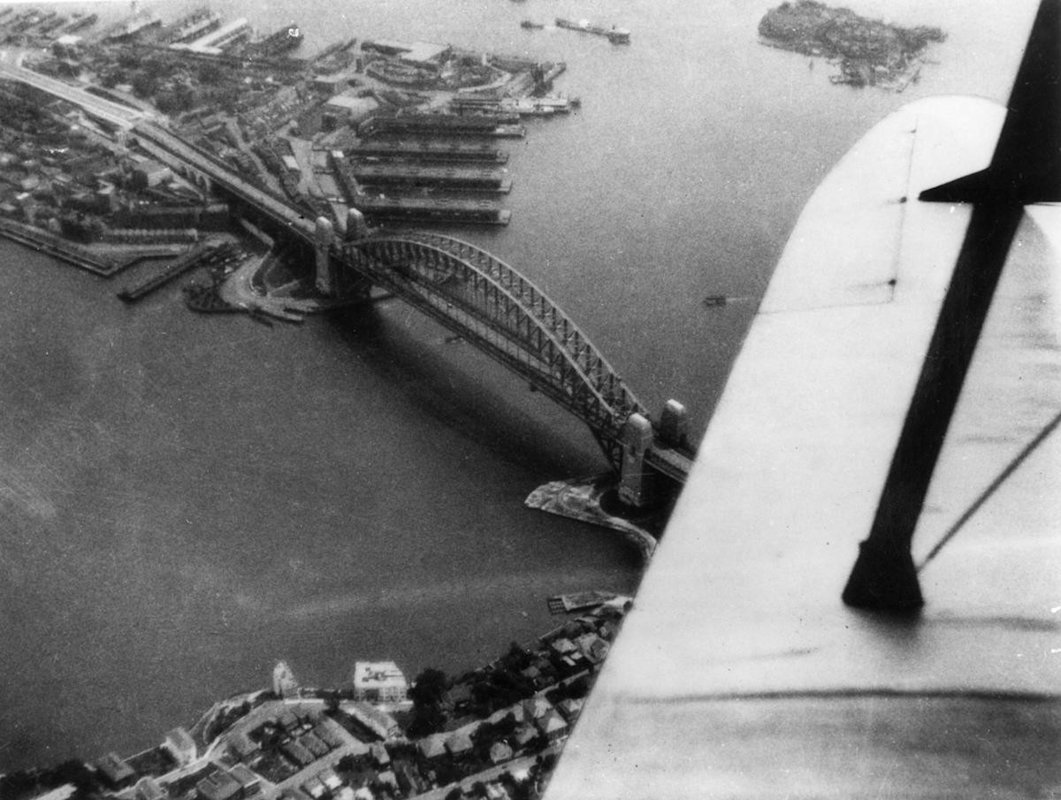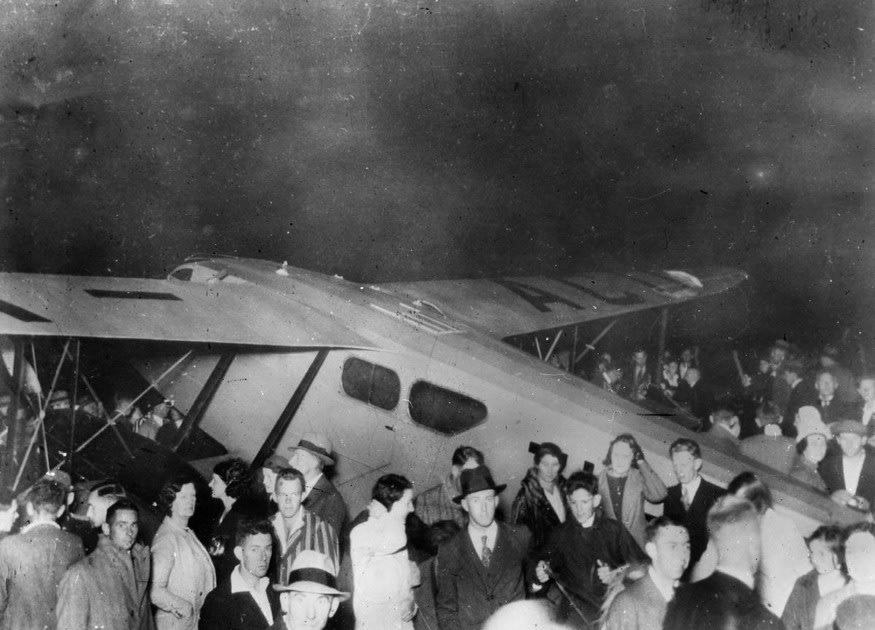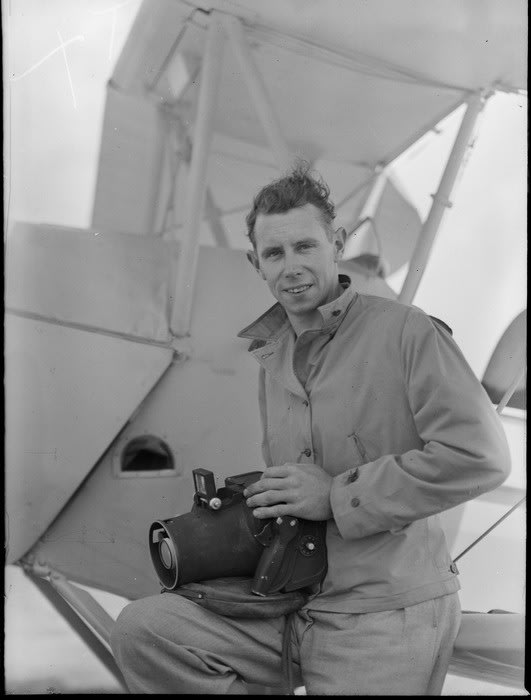The Little Known Life of Frank Stewart


Frank Stewart. Nov 1934. [Person in cockpit of aircraft], 11–0352. Walsh Memorial Library, The Museum of Transport and Technology (MOTAT).
Frank Stewart was a pioneer cinematographer in the early days of New Zealand cinema and later had a career in press photography specializing in aerial imagery. Though an influential presence in Aotearoa’s photographic history, we know little about him.
We have pieced together the varied life of Frank Stewart through investigating collections held at the Walsh Memorial Library, including an oral history interview with his son, Clyde ‘Snow’ Stewart (an renowned photographer in his own right).
“Pure interest”
Born in Woodbury, Canterbury, Frank was one of seven siblings. His father had worked in Australia and New Zealand’s gold fields before settling on a farm in New Zealand.
A university education provided Frank with chemistry basics. As his son Clyde ‘Snow’ Stewart recounts, this knowledge combined with his “pure interest” in photography helped him turn his photographic hobby into a career.

Frank Stewart. 1934. Auckland entrant and crew de Havilland 89 Rapide “Tainui”, 10–1442. Walsh Memorial Library, The Museum of Transport and Technology (MOTAT).
Establishing a reputation as a still photographer in the early 1900s, Frank transitioned into a career as a cameraman during the 1910s/20s. This was in the early days of New Zealand-produced silent films, and Frank became the owner of a small film-making company, New Zealand Films Limited in Wellington.
During this period Frank secured roles on a number of high profile filming projects. This included filming across the ditch at the Worlds Champion heavyweight boxing bout between Tommy Burns and Jack Johnson at Sydney Stadium in Rushcutters Bay, on Boxing Day 1908. Another example is the now mostly lost silent epic, The Birth of New Zealand (1922), a film telling the colonial narrative of New Zealand which Frank worked on as camera man.
Frank’s name continues to pop up in association with a number of known people in New Zealand film history. Mentioned as a cameraman on prolific film maker Rudall Hayward feature films including the1922 My lady of the cave and 1925 iconic film Rewi’s Last Stand. Frank also employed one of the future founders of the government-run New Zealand Film Unit, Cyril Morton at New Zealand Films Ltd.

Ngā Taonga Sound & Vision, Hayward Collection Reference: PO03843
Details of the early years of Frank’s cinematography are few and far between. It isn't until the 1920s that his work is more documented due to periods travelling the country capturing events for local news. Working with unperforated nitrate film (as it was cheaper), Frank would perforate the negatives himself and ensure the film was rapidly developed, meaning that material filmed that morning was ready to be shown that night to have news reports hot off the press.

Randall Hayward and Frank Stewart. Whites Aviation Ltd: Photographs. Ref: WA-44786-F. Alexander Turnbull Library, Wellington, New Zealand. /records/32053145
Clyde ‘Snow’ Stewart recalls that the original reels of many of his father’s films are lost, but records remain in institutional archives and newspaper records. For example, Frank’s work filming Arapuni construction was reported by the Waipa Post:
Volume XXIV, Issue 1688, 19 November 1925
These trips were a family event, quoted from Snow’s oral history below, Frank would take his wife Margaret and four children Bruce, Joy, Snow and Leslie along with him to filming locations:
“…[the] old car laden up with children and not photographic equipment, camping equipment we used to camp out on the job…In those days very often he took the family to camp. If he had a location somewhere down country, Arapuni was one place I could remember was mentioned quite a lot. And we’d set up a camp and he would do what was necessary in the way of photographing locally, on location they called it. Us kids would enjoy ourselves and do all sorts of things….”
Setting up business
In the 1930s Frank moved from film back to still photography, establishing Stewart’s Photo Service. Located on Auckland’s Queen Street, the firm did press photography and specialised in aerial photography working in partnership with Falcon Airways Limited.

Colour Talkies! Auckland Film History — №4, Auckland Star, Volume LXXII, Issue 193, 16 August 1941
Falcon Airways was a commercial flying service ran by Squadron Leader James Duff Hewett operating out of Ōrākei airstrip in a Gyspy Moth aircraft until the mid-1930s. Hewett and Stewart captured aerial imagery around the country. Together, they were first people to fly over Whakaari/White Island to film it from above. The pair drummed up news wherever they went as reported by the Bay of Plenty Times:
Captain Hewett, of Falcon Airways, Ltd., and Mr Frank Stewart, who will be well remembered here as the cinematographer of “My Lady of the Cave,” arrived in Tauranga by ’plane from Auckland late yesterday afternoon. It was Mr Stewart’s intention to photograph some aerial views of Tauranga this morning and then proceed for a similar purpose to Te Puke, returning to Auckland this afternoon. Captain Hewett and Mr Stewart were guests at Hotel Roslyn while in Tauranga. — Local and General, Bay of Plenty Times, Volume LXI, Issue 10923, 24 September 1932
Frank was based at Stewart’s Photo Service until 1934, when through his relationship with Hewett, he joined an Auckland crew in a England to Melbourne “great air race” which were part of the Australian Victorian Centenary Celebrations.
Race around the world

Frank Stewart. Oct 1934. MacRobertson Melbourne Air Race contestants at Mildenhall aerodrome prior to race start, 10–1443. Walsh Memorial Library, The Museum of Transport and Technology (MOTAT).
Sponsored by Australian confectionery mogul, Sir Macpherson Robertson, the race began on the 20 October 1932 from Mildenhall, England, with teams completing a route covering nineteen countries and seven seas with five compulsory stops in Baghdad; Allahabad; Singapore; Darwin and Charleville.

Frank Stewart. Oct 1934. Tainui at Mildenhall aerodrome, 11–0001. Walsh Memorial Library, The Museum of Transport and Technology (MOTAT).
Twenty teams from seven countries began the grueling race, with Stewart acting as wireless operator and unofficial photographer for the Auckland team. Stewart’s team mates were former business partner, Squadron Leader Jim Hewett as pilot, and navigator Cyril Kay, flying in ZK-ACO Tainui a twin-engine de Havilland Dragon Rapide.
Frank’s photographs document Tainui’s journey through the race, capturing scenes on the ground of participants, refueling at fuel and compulsory stops. The images below show Tainui with a crowd in Athens, Greece. His aerial photography skills also allowed for unique scenes to be captured mid flight.


<C> Frank Stewart. Oct 1934. [Aerial view of Bangkok], 11–0022. Walsh Memorial Library, The Museum of Transport and Technology (MOTAT).
The MacRobertson Race was divided into speed and handicapped sections, and for two of the handicapped sections Tainui came in second. However, an accident during taxiing in the dark in Cloncurry, Australia caused damage to the aircraft and required repairs which lost the team some time.
Tainui arrived in Melbourne 13 days 18 hours and 15 minutes after leaving Mildenhall, with an elapsed fly time of 106 hours and 51 minutes. This performance put the Auckland Team as third in the handicap race and fifth overall. It was an impressive effort for a team of three who covered almost 20,000 miles in an air race where only half of those that began the race finished it.

<C> Frank Stewart. 1934. [Aerial view over Sydney], 11–0345. Walsh Memorial Library, The Museum of Transport and Technology (MOTAT).
After landing in Melbourne, the Tainui team continued onto New Zealand in an attempt to demonstrate the feasibility of an England to New Zealand air route. Hewett, Kay and Stewart flew from Richmond, Sydney directly across the Tasman Sea to Palmerston North, New Zealand, where they were welcomed with a crowd and celebration dinner.

<C> Frank Stewart. Nov 1934. [de Havilland 89 Rapide “Tainui” ZK-ACO crew at dinner in Palmerston North], 11–0348. Walsh Memorial Library, The Museum of Transport and Technology (MOTAT).
At the time this was the first direct flight from England to New Zealand, and set a number of records, including being the first New Zealanders to fly the Tasman, and set the crossing record at 12 hours and 9 minutes which stood for several years.

Stewart and White Limited
With the completion of the MacRobertson Air Race, Frank returned to Auckland and continued with aerial photography, this time setting up a photography studio called Stewart and White Limited. The firm opened in 1935, and was co-owned by Frank and well known aviator and photographer Leo White.
Leo White would later go on to establish photography and magazine studio Whites Aviation Limited with Frank’s son, Clyde ‘ Snow’ Stewart. Author Peter Alsop notes, “…in Stewart & White, a photography company that, in practical effect, Whites Aviation reincarnated after the war”.

Stewart and White Limited. Maurice Clarke, Manager, Union Airways, c 1930, 13–0342. Walsh Memorial Library, The Museum of Transport and Technology (MOTAT).
Success for Stewart and White came from the combination of Frank’s business acumen from previous ventures and White’s reputation and contacts in aviation. Their offices were located in His Majesty’s Arcade on Queen Street, the firm specialised in aerial photography, capturing aviation related commissions — like accompanying the Imperial Airways Short S23 flying boat Centaurus during a survey flight around New Zealand in 1937–1938, or photographing key events in New Zealand for publication in serials such as the Weekly News.

Stewart and White Limited. 03 Apr 1940. [Crew after arrival of Awarua], PHO-2018–6.8. Walsh Memorial Library, The Museum of Transport and Technology (MOTAT).
In 1940 when the firm was in full swing, Snow Stewart, who had left school at 13, was employed at his father’s firm on the day of the arrival parade of HMS Achilles in Auckland on 23 February 1940. While Frank and Leo White were capturing aerial images of the ship in the harbour, and of the parade, Snow was back at the Stewart and White Ltd offices on Queen Street. By sneaking out of the dark room windows to a balcony overlooking Queen Street, Snow captured an image of the 100,000 strong crowds and confetti celebrating the Achilles parade. Snow describes how he developed and printed the image before his father and White returned to the office. The photograph was published as a full page image in the Freelance newspaper.

Unidentified. 23 Feb 1940. [Crowds welcoming return of HMS Achilles], 15/043/005. Walsh Memorial Library, The Museum of Transport and Technology (MOTAT).
Stewart and White Ltd continued until the advent of World War Two, when the banning of civilian aerial photography and scarcity of photographic materials during the war forced the firm to close. From there, Leo White joined the RNZAF as a photographer capturing images which furthered his reputation in aerial photography.
Frank remained in Auckland, where he continued practicing photography. Including photographing capacity-plans for American Liberty cargo ships when docked in New Zealand. For a time during World War Two, Clyde Stewart joined his father in his photography work. In his oral history Clyde describes how Frank would collect the plans from the port, rush back to his home on the limited petrol allowance provided by the government to image the plans, then drive back to the ships with copied plans.

The Liberty ship is a hive of industry from the moment the keel is laid. Prefabricated parts are brought to the assembly point from inland factories. Supplement to the Auckland Weekly News 11 November 1942 p015, Auckland Libraries Heritage Collections AWNS-19421111–15–1,
In many ways Franks legacy was continued on by Snow, who, after working with his father, re-joined the RNZAF to work under Leo White as a photojournalist. This working relationship continued post war with Snow becoming an integral part of Whites Aviation as colourist, production manager and chief photographer.

Portrait of Clyde (Snow) Stewart, Production Manager for Whites Aviation, holding a K 20 aerial camera in front of a Tiger Moth biplane. Whites Aviation Ltd: Photographs. Ref: WA-00867-G. Alexander Turnbull Library, Wellington, New Zealand. /records/30654500
Frank Stewart’s career in cinematography and aerial imagery meant he was an influential figure in early New Zealand photography. However, except for a few excerpts and by-lines, his cinematography work has largely been forgotten by the general public, and his involvement in aerial imagery has been poorly documented in comparison with his contemporaries.
Searching through archives held by MOTAT, National Library of New Zealand and other institutions, I have been able to illustrate Frank Stewart’s role in New Zealand’s history of film and photography. But, it is by listening to the oral history of his son that we can gleam an idea of him as a person. As described by Snow he was “a character with a charming manner… but a terrible car driver, bit erratic …but a good photographer.”
References
https://nzhistory.govt.nz/people/leo-white
https://teara.govt.nz/en/biographies/4w14/white-leo-lemuel/sources
https://www.noted.co.nz/culture/culture-arts/whites-of-our-eyes-how-hand-coloured-aerial-photography-came-to-define-the-new-zealand-landscape
https://paperspast.natlib.govt.nz/newspapers/AS19410816.2.147?items_per_page=10&page=4&query=%22Frank+Stewart%22&snippet=true&sort_by=byDA.rev
https://paperspast.natlib.govt.nz/newspapers/AS19410802.2.158?items_per_page=10&page=4&query=%22Frank+Stewart%22&snippet=true&sort_by=byDA.rev
https://paperspast.natlib.govt.nz/newspapers/BOPT19320924.2.8?items_per_page=10&query=%22Frank+Stewart%22+cinematographer&snippet=true&sort_by=byDA.rev
https://paperspast.natlib.govt.nz/newspapers/BOPT19231222.2.5?items_per_page=10&query=%22Frank+Stewart%22+cinematographer&snippet=true&sort_by=byDA.rev
https://paperspast.natlib.govt.nz/newspapers/FRTIM19341203.2.11?query=%22Frank+Stewart%22&snippet=true
https://paperspast.natlib.govt.nz/newspapers/WAIPO19251119.2.35.3?query=%22Frank+Stewart%22&snippet=true
https://paperspast.natlib.govt.nz/newspapers/NZH19341018.2.65?query=%22Frank+Stewart%22&snippet=true
https://paperspast.natlib.govt.nz/newspapers/FRTIM19341203.2.11?query=%22Frank+Stewart%22&snippet=true
https://drive.google.com/viewerng/viewer?url=https://www.pottonandburton.co.nz/wp-content/uploads/2016/08/Hand-Coloured-New-Zealand-Sampler.pdf
https://www.ngataonga.org.nz/collections/catalogue/catalogue-item?record_id=67715
https:/www.nzonscreen.com/profile/cyril-morton/biography
https://www.uivermemorial.org.au/race.html
https://www.sl.nsw.gov.au/stories/aviation-australia/macrobertson-centenary-air-race
https://www.ngataonga.org.nz/collections/catalogue/catalogue-item?record_id=275807
https://www.ngataonga.org.nz/collections/catalogue/catalogue-item?record_id=65125